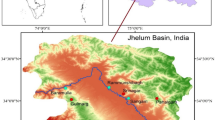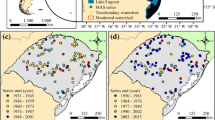Abstract
Knowledge of the pattern of occurrence of peak runoff events is valuable for managing activities in watercourses and their environs. Current approaches consider the inter-arrival intervals between events as being exponentially distributed with a fixed seasonal parameter. In a new approach (Ben-Zvi and Meirovich, Stochastic Hydrology and Hydraulics, 1997) the occurrence day is considered as a random variable to whose series a gradually-varied distribution, such as the normal or Pearson III function, can be fitted. The statistical moments of occurrence days facilitate such fits. The present work extends the consideration, via a case study of partial duration series, to the occurrence times of high-discharge events. The first three statistical moments of occurrence days in series of runoff peaks have been determined for a sample of nine hydrometric stations in Israel. The mean occurrence day of high peaks at eight stations falls earlier than that of respective low peaks, whilst for one station the opposite trend is observed. The shifts at five stations are found statistically significant. The standard deviations of occurrence days in partial duration series for the sample stations are mostly shorter than those in the respective complete series of events. The occurrence days of runoff events in the complete series at seven stations are about evenly distributed around their respective mean, whereas most of the other occurrence series are skewed.
Similar content being viewed by others
References
Alexander, G. N.: 1959, Return periods relationships, J. Geoph. Res. 64, 675–682.
Ashkar, F. and Rousselle, J.: 1987, Partial duration series modeling under the assumption of Poissonian flood count, J. Hydrol. 90, 135–44.
Ben-Zvi, A.: 1988a, Maximal discharges observed in Israel, J. Environ. Geol. and Water Sci. 11, 15–20.
Ben-Zvi, A.: 1988b, Enhancement of runoff from a small watershed by cloud seeding, J. Hydrol. 101, 291–303.
Ben-Zvi, A.: 1991, Observed advantage for negative binomial over Poisson distribution in partial duration series, Stoch. Hydrol. Hydraul. 5, 135–146.
Ben-Zvi, A. and Fanar, A.: 1996, Effect of cloud seeding on rainfall intensities in Israel, Isr. J. Earth Sci. 45, 39–45.
Ben-Zvi, A. and Langerman, M.: 1993, Assessment of runoff enhancement by randomized cloud seeding in case of a carry-over flow, J. Hydrol. 142, 391–408.
Ben-Zvi, A. and Meirovich, L.: 1997, Direct probabilistic description of arrival times of runoff events within the year, Stoch. Hydrol. Hydraul. 11, 511–521.
Chang, T. J.: 1987, Analysis and simulation of three-component floods in the Ohio River Basin, in: V. P. Singh (ed.) Hydrologic Frequency Modeling, D. Reidel, Dordrecht, The Netherlands, pp. 583–594.
Cruise, J. F. and Arora, K.: 1990, A hydroclimatic application strategy for the Poisson partial duration model, Water Resour. Bull. 26, 431–442.
Cunnane, C.: 1973, A particular comparison of annual maxima and partial duration series methods of flood frequency prediction, J. Hydrol. 18, 257–271.
Gupta, V. K., Duckstein, L. and Peebles, R. W.: 1976, On the joint distribution of the largest flood and its time of occurrence, Water Resour. Res. 12, 295–304.
Johnson, N. L. and Kotz, S.: 1969, Continuous Univariate Distributions, Houghton-Mifflin, New York, NY, U.S.A.
Katsenelson, Y.: 1955, Rainfall Intensities in Israel, Meteorol. Papers, Series E, No. 3, Meteorol. Service, Jerusalem (now at Bet Dagan), Israel (in Hebrew).
Katsenelson, Y.: 1956, Distribution of Rainfall in Israel in Accordance with the Area and Time, Meteorol. Papers, Series E, No. 5, Meteorol. Service, Tel-Aviv (now at Bet Dagan), Israel (in Hebrew).
Kavvas, M. L.: 1982, Stochastic trigger model for flood peaks, 1. Development of the model, Water Resour. Res. 18, 383–398.
Kirby, W.: 1969, On the random occurrence of major floods, Water Resour. Res. 5, 778–784.
Kisiel, C. C., Dukstein, L. and Fogel, M. M.: 1971, Analysis of ephemeral flow in aridlands, J. Hydraul. Div. ASCE 97, 1699–1717.
Lomas, J., Zemel, Z. and Shashua, Y.: 1976, Rainfall Probabilities in Israel as a Basis for Design and Agricultural Activity, Agromet. Rep. 1/76, Meteorol. Service, Bet-Dagan, Israel (in Hebrew).
Meteorological Service: 1967, Standard Climatic Means of Rainfall Amounts 1931-1960, Meteorol. Papers, Series A, Rep. 21, Meteorol. Service, Bet-Dagan, Israel (in Hebrew).
Meteorological Service: 1990, Standard Climatic Means of Rainfall Amounts 1961-1990 and a Preliminary Summary, Meteorol. Service, Bet-Dagan, Israel (in Hebrew).
Nachtnebel, H. P. and Konecny, F.: 1987, Risk analysis and time-dependent flood models, J. Hydrol. 91, 295–318.
North, M.: 1980, Time-dependent stochastic model of floods, J. Hydraul. Div. ASCE 106, 649–665.
Rosbjerg, D.: 1985, Estimation in partial duration series with independent and dependent peak values, J. Hydrol. 76, 183–195.
Shane, R. M. and Lynn, W. R.: 1964, Mathematical model for flood risk evaluation, Proc. Hydraul. Div. ASCE 90, 1–20.
Sharon, D. and Kutiel, H.: 1986, The distribution of rainfall intensity in Israel, its regional and seasonal variations and its climatological evaluation, J. Climat. 6, 277–291.
Shentsis, I, Ben-Zvi, A. and Golts, S.: 1997, A physically-related regional model for extreme discharges in Israel, Hydrol. Sci. J. 42, 391–404
Todorovic, P. and Rousselle, J.: 1971, Some problems of flood analysis, Water Resour. Res. 7, 1144–1150.
Todorovic, P. and Woolhiser, D. A.: 1972, On the time when extreme flood occurs, Water Resour. Res. 8, 1433–1438.
Wang, Q. J.: 1991, The POT model described by the generalized Pareto distribution with Poisson arrival rate, J. Hydrol. 129, 263–280.
Author information
Authors and Affiliations
Rights and permissions
About this article
Cite this article
Ben-Zvi, A., Azmon, B. Distribution of Occurrence Days of Runoff Peaks in Israel and its Shifts for High-Discharge Events. Water Resources Management 12, 313–324 (1998). https://doi.org/10.1023/A:1008031612703
Issue Date:
DOI: https://doi.org/10.1023/A:1008031612703




